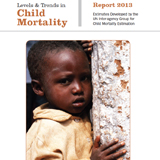
Summary
Millennium Development Goal 4 (MDG 4) calls for reducing the under-five mortality rate by twothirds between 1990 and 2015. The world has made substantial progress, reducing the under-five mortality rate 47 percent, from 90 (89, 92) deaths per 1,000 live births in 1990 to 48 (46, 51) in 2012. However, this progress has not been enough, and the target risks being missed at the global level. To achieve MDG 4 on time, the global annual rate of reduction in under-five mortality rate would need to rise to 15.6 percent for 2012–2015, much faster than the 3.9 percent achieved over 2005–2012. At the country level, historical trends show that progress for most countries has been too slow and that only 13 of the 61 countries with high under-five mortality rates (at least 40 deaths per 1,000 live births in 2012) are currently on track to achieve MDG 4—with an average annual rate of reduction of 4.4 percent or more.
Still, in 2012, 6.6 (6.3, 7.0) million children died before reaching their fifth birthday, mostly from preventable causes and treatable diseases, even though the knowledge and technologies for life-saving interventions are available. In addition, inequities in child mortality between highincome and low-income countries remain large. In 2012 the under-five mortality rate in lowincome countries was 82 deaths per 1,000 live births—more than 13 times the average rate in high-income countries (6). Many countries still have very high under-five mortality rates—particularly those in Sub-Saharan Africa, home to all 16 countries with an under-five mortality rate above 100 deaths per 1,000 live births. Reducing these inequities across countries and saving more children’s lives by ending preventable child deaths are important priorities.
In 2012 the governments of Ethiopia, India and the United States, in close collaboration with UNICEF, convened the Child Survival Call to Action Forum to mobilize political leadership to end preventable child deaths. Partners emerged from the Call to Action with a revitalized commitment to child survival under the banner of A Promise Renewed. More than 170 governments have signed a pledge to redouble their efforts to end preventable child deaths so that more countries achieve MDG 4 and sustain momentum beyond 2015.
As global impetus and investment for accelerating child survival grow, monitoring progress at the global and country levels has become even more critical. The United Nations Inter-agency Group for Child Mortality Estimation (UN IGME) updates child mortality estimates annually, and this report presents the UN IGME’s latest estimates of under-five, infant and neonatal mortality and assesses progress towards MDG 4 at the country, regional and global levels.
Progress Towards Millennium Development Goal 4: Facts and Figures
- Overall, substantial progress has been made towards achieving MDG 4. The number of under-five deaths worldwide has declined from 12.6 (12.4, 12.9)1 million in 1990 to 6.6 (6.3, 7.0) million in 2012. While that translates into around 17,000 fewer children dying every day in 2012 than in 1990, it still implies the deaths of nearly 18,000 children under age five every day in 2012.
- Since 1990 the global under-five mortality rate has dropped 47 percent—from 90 (89, 92) deaths per 1,000 live births in 1990 to 48 (46, 51) in 2012. All regions, except for Sub-Saharan Africa and Oceania, have reduced their under-five mortality rate by 50 percent or more.
- The average annual rate of reduction in under-five mortality has accelerated— from 1.2 percent a year over 1990–1995 to 3.9 percent over 2005–2012—but remains insufficient to reach MDG 4, particularly in Oceania, Sub-Saharan Africa, Caucasus and Central Asia, and Southern Asia.
- The highest rates of child mortality are still in Sub-Saharan Africa, with an under-five mortality rate of 98 deaths per 1,000 live births—more than 15 times the average for developed regions.
- Sub-Saharan Africa, however, has seen a faster decline in its under-five mortality rate over time, with the average annual rate of reduction increasing from 0.8 percent in 1990–1995 to 4.1 percent in 2005–2012.
- About half of under-five deaths occur in only five countries: India, Nigeria, Democratic Republic of the Congo, Pakistan and China. India (22 percent) and Nigeria (13 percent) together account for more than a third of all under-five deaths.
- The proportion of under-five deaths that occur within the first month of life (the neonatal period) has increased 19 percent since 1990, from 37 percent to 44 percent, because declines in the neonatal mortality rate are slower than those in the mortality rate for older children.
- Around two-thirds of neonatal deaths occur in just 10 countries, with India accounting for more than a quarter and Nigeria for a tenth.
- Sub-Saharan Africa, with the highest risk of death in the first month of life, is among the regions showing the least progress in reducing the neonatal mortality rate.
- The leading causes of death among children under age five include pneumonia (17 percent of all under-five deaths), preterm birth complications (15 percent), intrapartum-related complications (complications during birth; 10 percent), diarrhoea (9 percent) and malaria (7 percent). Globally, about 45 percent of under-five deaths are attributable to undernutrition.